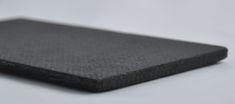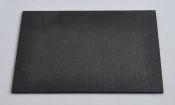New low-cost, high-temp resins
MG Resins offer a suite of properties and processing that could potentially revolutionize sectors of the composites industry.

MG Resins offer ultra-low flammability, heat release and smoke release, polyimide-type high-temperature resistance with the cost and processing of epoxies, can be cured to a thermoplastic below 110°C and to an almost pure carbon at much higher temperatures. SOURCE: CRG and CW.
Cornerstone Research Group Inc. (CRG, Dayton, OH, US) specializes in non-metallic materials and manufacturing research & development for both government and commercial organizations. It actively pursues new technology commercialization and has spun off several companies that are active in the composites industry. The company is well-diversified, with Small Business Innovation Research (SBIR) grants comprising less than 25% of its total programs.

Cornerstone Research Group has spun off several commercial companies that participate in the composites industry including Spintech LLC, Advantic and NONA Composites. SOURCE: Cornerstone Research Group.
CRG has introduced a completely new polymer system that has demonstrated high-temperature resistance like a polyimide (service temp. 300-450°C) as well as ultra-low flammability, heat release and smoke release, yet is similar to two-part epoxy resins in processability and cost. Moreover, these systems cure to a thermoplastic state at temperatures below 110 °C, cross-link to a thermoset at temperatures above 110 °C and can be converted to an almost pure carbon material at higher temperatures.
MG Resins have been used to make composite test specimens from glass and carbon fiber fabric and carbon fiber felt. SOURCE: Cornerstone Research Group
MG Resins can be combined with fiber reinforcement using conventional processing techniques, offering the potential for low-cost, high temperature structural composites. Water is the only volatile generated, thus processing does require management of porosity, similar to condensation-reaction polymers like phenolics and polyimides. However, initial testing of MG Resin composites shows an order of magnitude lower heat release vs. phenolics.
MG 1000 test samples were made using glass and carbon fiber fabrics and carbon fiber felt using vacuum infusion and hand layup. Carbon fiber panels and carbon felt panels were autoclave cured at 200-250°C and 100 psi with a 2-hr post-cure at either 250°C or 315°C. Glass fiber specimens were oven-cured at 250°C. MG 3000 test samples were prepared in a similar manner. Syntactic test panels were also produced using milled fiber and resin in an effort to explore low-density materials for potential use in ablative and thermal protection systems (TPS) for spacecraft. Overall, the resulting composites processed well, though further optimization of polymer formulations, processing and cure cycles is ongoing to reduce void content. Programs are also in progress to fully characterize the MG 1000 and MG 3000 resin systems and composite laminates.
New frontiers in FST performance
The microscale combustion calorimeter (MCC) was developed by the Federal Aviation Administration (FAA, Washington, DC, US) as a tool to obtain meaningful data from small-sized samples to improve fire safety for aircraft. Testing is conducted for a fixed amount of time with a very rapid heating rate of 1°C/s. The MCC test data below are from a test ramping temperature from 150-950°C in 800 seconds. Results show the potential of MG Resins to offer dramatic improvement vs. phenolic resins, the current mainstay in aircraft interiors, with a peak heat release of only 7 W/g vs. phenolic’s 80 W/g.
Micro Combustion Calorimeter Flammability Properties
of MG Resins vs. Other Polymers

SOURCE: Cornerstone Research Group
Cone calorimetry tests are used for aircraft and submarine interiors, measuring heat and smoke release as well as flammability. The cone-shaped heat source provides a constant heat flux from 0 to 100 kW/m2. Heat release analysis typically requires three specimens to be tested at each of the following levels: 25, 35, 50, 75, and 100 kW/m². The table below shows preliminary test results for MG 1000 composites tested at 75 kW/m2. Mil-STD-2031, which includes the fire standard for submarines, is generally considered one of the most difficult flame, smoke and toxicity (FST) standards to meet. The MG 1000/glass fabric composite passed Mil-STD-2031 for heat release while the syntactic showed even better performance. The smoke release for both samples was very low, within the baseline noise for the testing instrument, which is exciting because polymers with low release of both heat and smoke are rare. Further testing is in progress to better understand these results and further characterize MG Resins FST performance.

SOURCE: Cornerstone Research Group
MG 1000 was also exposed to heating fluxes similar to what spacecraft structures must withstand during re-entry. The front face of a carbon plain weave fabric/MG 1000 composite was exposed to a moderate flux of 252 W/cm2, reaching over 1925°C during a 20-second exposure with almost no increase in temperature on the back side. A carbon felt composite was exposed to a flux of 700 W/cm2 — two to three times the rate projected for Mars and Venus mission spacecraft — with front side temperatures exceeding 3000°C while the back side temperature registered less than 94°C.
Potential and path forward
Cornerstone Research Group’s technology leader Rick Hreha presented initial test data on MG Resin composites for ablative thermal protection at the 2015 High Temple Workshop (short for High Temperature Polymeric Laminate) in Muscle Shoals, Alabama.
Hreha will present “MG Resins: New Low-cost, High-temperature Resins” from 10:30 – 10:55 on Wednesday, Oct. 28 at the upcoming Composites and Advanced Materials Expo (CAMX 2015, Oct. 26-29, Dallas, TX, US) in Room D172. Samples of MG Resin composites will also be on display at the Cornerstone Research Group booth M92 in the CAMX 2015 Exhibit Hall.
“This is a totally new type of polymer system,” says Michael Rauscher, director of Cornerstone Research Group’s R&D Center. “Initially, we saw it as providing the properties of a polyimide while being an easy-to-process system with a projected cost close to epoxy.” Now, however, the group has uncovered a wide range of unique properties that make it a potential game-changer for applications like aircraft and submarine interiors, spacecraft structures with integrated thermal protection systems and composite structures for other high-temperature applications.
“The same material can be processed as a 2-part liquid polymer system for infusion or as a thermoplastic,” says Rauscher. With the thermoplastic MG Resins, CRG is developing sprayable paints and filament products for additive manufacturing. Prepreg products are on the horizon as well. Because the material converts to almost pure carbon at much higher process temps, MG Resins may also enable carbon fiber-reinforcements to be infused and then more quickly graphitized into carbon-carbon composites vs. today’s lengthy and expensive chemical vapor deposition processes. Rauscher invites companies to visit during CAMX and learn more about MG Resins.
Related Content
Röchling launches sustainable vacuum forming materials for railway structures
Röchling’s Maywoflamm plus RC and Maywoflamm NFPA RC can be manufactured using up to 70% recycled material, making it possible to increase sustainability in customer applications.
Read MoreMaterials & Processes: Fibers for composites
The structural properties of composite materials are derived primarily from the fiber reinforcement. Fiber types, their manufacture, their uses and the end-market applications in which they find most use are described.
Read MoreVoith H2 storage tanks made with in-house towpreg winding
Plug & Drive H2 storage system displayed at IAA Transportation 2022 uses 700-bar tanks for heavy-duty commercial and construction vehicles.
Read MoreKimya features Kimya PC-FR 3D filament for the transportation sector
Flame-retardant polycarbonate filament reaches EN45545 certification and meets REACH and RoHS standards for production of parts in railway, automotive, electronics.
Read MoreRead Next
From the CW Archives: The tale of the thermoplastic cryotank
In 2006, guest columnist Bob Hartunian related the story of his efforts two decades prior, while at McDonnell Douglas, to develop a thermoplastic composite crytank for hydrogen storage. He learned a lot of lessons.
Read MoreCW’s 2024 Top Shops survey offers new approach to benchmarking
Respondents that complete the survey by April 30, 2024, have the chance to be recognized as an honoree.
Read MoreComposites end markets: Energy (2024)
Composites are used widely in oil/gas, wind and other renewable energy applications. Despite market challenges, growth potential and innovation for composites continue.
Read More
























.jpg;maxWidth=300;quality=90)







